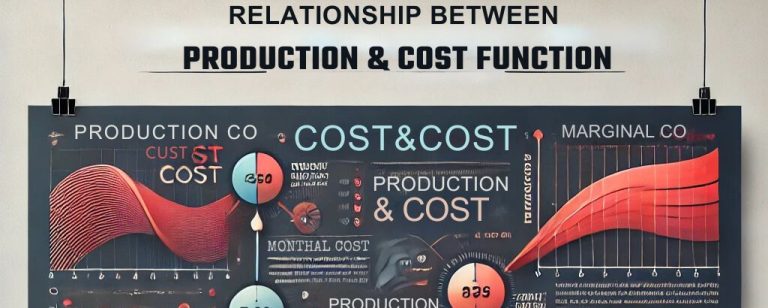The relationship between production function and cost function is vital for understanding how businesses produce goods and incur costs. The production function describes the different inputs labor, capital, and raw materials to combine in producing output, whereas the cost function explains the relation between the level of production and the costs incurred while producing. These two functions are closely related since changes in production levels directly affect costs and costs subsequently influence pricing and profitability decisions.
What is Production Function?
A production function defines how inputs, such as labor, capital, and raw materials, are combined to produce output. Essentially, it represents the technical relationship between factors of production and the final goods or services produced. This helps businesses determine the most efficient combination of resources to maximize production.
Where:
- Q = Quantity of bread produced
- L = Labor (number of workers)
- K = Capital (number of ovens)
Example of a Production Function
Let’s consider a bakery. The bakery uses two main inputs:
- Labor (L): Number of workers.
- Capital (K): Machines and ovens used for baking.
If the bakery employs 5 workers and uses 3 ovens, it might produce 100 loaves of bread. If it employs 10 workers and uses 4 ovens, it could produce 250 loaves. The production function helps the bakery understand the relationship between labor, capital, and output.
What is Cost Function?
The cost function describes the relationship between the quantity of output produced and the total costs incurred by a company. It helps businesses determine how different levels of output affect their costs, which is crucial for setting prices, managing production, and maximizing profits.
Example of a Cost Function
Let’s use the example of the bakery again. The bakery’s fixed costs (such as rent, salaries of permanent staff, and equipment maintenance) remain constant, regardless of how many loaves of bread are produced. However, variable costs, such as flour, sugar, and electricity, increase as the bakery produces more loaves.
The cost function is typically expressed as:
Where:
- TC = Total cost
- FC = Fixed cost
- VC(Q) = Variable cost, depending on the quantity of output (Q)
If the bakery produces 100 loaves, its total cost might be ₹500. If it produces 200 loaves, the total cost might rise to ₹900, reflecting the increase in variable costs.
Relationship Between Production Function & Cost Function
The relationship between production function and cost function is inherently tied to the concept of efficiency and output. As the production function determines the quantity of output produced based on various inputs, the cost function reflects the expenses associated with producing that output. Understanding this relationship is crucial for businesses to make informed decisions about scaling production, managing costs, and pricing products.
- Increasing Production: As a business increases its output, the production function indicates how much more labor and capital are needed. This, in turn, affects the cost function, particularly the variable costs, which will increase with higher production levels.
- Decreasing Returns to Scale: In many cases, businesses experience diminishing returns as they increase production. This means that adding more inputs (like labor or machines) leads to smaller increases in output, resulting in higher marginal costs. This behavior can be analyzed through both the production and cost functions.
- Fixed vs Variable Costs: The production function shows how the output is generated from inputs, while the cost function reveals how much the business must pay for those inputs. Fixed costs remain constant, regardless of the level of production, while variable costs increase as production levels increase.
Example: Relationship in Action
Let’s use the same bakery example:
- If the bakery produces 100 loaves of bread, the cost function shows a total cost of ₹2500.
- If the bakery increases production to 200 loaves, the production function will indicate how much more labor and equipment are needed to produce the extra loaves.
- The cost function will then reflect the increase in variable costs (more flour, more electricity, more labor), and the total cost will rise. However, if production rises further, the bakery may experience diminishing returns—producing 200 loaves may cost more than expected due to inefficiencies in the production process.
Why This Relationship is Important?
- Cost Control: Understanding the relationship allows businesses to optimize production processes, reduce waste, and minimize costs.
- Pricing Strategy: A business can set appropriate prices by calculating the marginal cost of production and factoring in the relationship between production and cost.
- Profit Maximization: Analyzing both functions helps businesses identify the optimal level of production that maximizes profits.
Conclusion
The relationship between production function and cost function is crucial for businesses to understand their production processes and manage their expenses effectively. The production function provides insights into how inputs contribute to output, while the cost function shows the financial impact of those outputs. By understanding this relationship, businesses can optimize their resource allocation, control costs, and enhance profitability. The key to success lies in balancing production levels with the costs incurred, ensuring that production is efficient and cost-effective.
Relationship Between Production & Cost Function FAQs
What is a production function?
The production function is a mathematical expression of the relationship between inputs such as labor, capital, and others, which in sum, generate output.
What is a cost function?
The cost function specifies the relationship between the level of output produced. The total amount of cost incurred consists of fixed and variable costs.
How does the production function impact costs?
As production increases, the production function determines the necessary inputs, which then leads to higher costs in the cost function, especially variable costs.
Why is the relationship between production function and cost function important?
This relationship helps businesses optimize their production processes, control costs, and set competitive pricing strategies.
What are fixed costs in the cost function?
Fixed costs are such costs that do not alter with the level of outputs, for example, rent, salary, and insurance.


